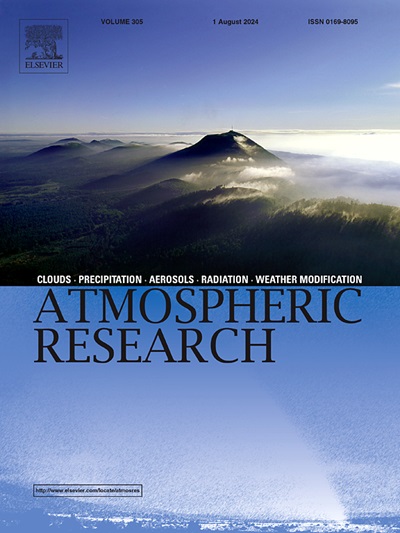How well do the reanalysis datasets capture hot and cold extremes and their trends in India?
IF 4.5
2区 地球科学
Q1 METEOROLOGY & ATMOSPHERIC SCIENCES
引用次数: 0
Abstract
Much of the Earth's surface lacks long-term in-situ measurement of essential meteorological variables. Climate reanalysis datasets provide an alternative in data-sparse regions, sometimes replacing gauge-based observations for climatological studies, however, they have inherent biases. Reanalysis is now available at finer spatial and temporal resolutions, that can be considered for hydrological and climatological studies. Although the assessment of reanalysis datasets is common at a daily, monthly, or seasonal scale, how the recent generation reanalysis captures the spatial pattern of extreme temperature events, and their trends remains an open question.
In this study, two regional (IMDAA and EARS) and five global (ERA5-Land, ERA5, MERRA2, CFSR, and JRA3Q) reanalysis datasets are evaluated with a gauge-based gridded temperature dataset from the India Meteorological Department (IMD) to assess their suitability for studying extreme temperature events and their trends over India. Fifteen hot and cold extremes indices are identified to characterize extremes covering frequency, intensity, and duration of extreme temperature events.
The study finds that no single reanalysis outperforms others for all the extreme indices when compared to the IMD gridded data, however, a select few (e.g., ERA5, ERA5L, MERRA2, and JRA3Q) better perform in reproducing the observed spatial pattern of extreme events and their changes across different regions of India. It is also noted that in response to global warming, the frequency, duration, and magnitude of extreme hot events are rising, and cold events are decreasing in India which is also captured by most of these reanalyses. Overall, the increase in hot extremes is more prominent in the south of the tropics and the decline in cold extremes is more evident in the north. However, the trend areas and magnitudes of the reanalysis datasets were not similar in comparison to trends from a regional station-based gridded dataset. Thus, care should be taken when selecting datasets for such applications and interpreting their trends.
再分析数据集如何很好地捕捉了印度的极端高温和极端低温及其趋势?
地球表面的大部分地区缺乏对基本气象变量的长期原位测量。气候再分析数据集在数据稀疏的地区提供了另一种选择,有时可以代替基于测量仪的观测进行气候学研究,然而,它们具有固有的偏差。现在可以进行更精细的空间和时间分辨率的再分析,可以考虑用于水文和气候学研究。虽然对再分析数据集的评估在日、月或季节尺度上很常见,但最近一代的再分析如何捕捉极端温度事件的空间格局及其趋势仍然是一个悬而未决的问题。本研究利用印度气象部门(IMD)的栅格温度数据集,对两个区域(IMDAA和EARS)和五个全球(ERA5- land、ERA5、MERRA2、CFSR和JRA3Q)再分析数据集进行了评估,以评估它们对研究印度极端温度事件及其趋势的适用性。确定了15个极端高温和极端低温指数,以表征极端温度事件的频率、强度和持续时间。研究发现,与IMD网格数据相比,没有一个单一的再分析在所有极端指数上都优于其他再分析,然而,少数再分析(例如,ERA5、ERA5L、MERRA2和JRA3Q)在再现观测到的极端事件的空间格局及其在印度不同地区的变化方面表现更好。报告还指出,为了应对全球变暖,印度极端高温事件的频率、持续时间和强度都在上升,而寒冷事件正在减少,这也被大多数重新分析所捕捉到。总的来说,极端炎热天气的增加在热带南部更为明显,而极端寒冷天气的减少在北部更为明显。然而,再分析数据集的趋势面积和幅度与区域站格数据集的趋势并不相似。因此,在为此类应用选择数据集并解释其趋势时,应小心谨慎。
本文章由计算机程序翻译,如有差异,请以英文原文为准。
求助全文
约1分钟内获得全文
求助全文
来源期刊

Atmospheric Research
地学-气象与大气科学
CiteScore
9.40
自引率
10.90%
发文量
460
审稿时长
47 days
期刊介绍:
The journal publishes scientific papers (research papers, review articles, letters and notes) dealing with the part of the atmosphere where meteorological events occur. Attention is given to all processes extending from the earth surface to the tropopause, but special emphasis continues to be devoted to the physics of clouds, mesoscale meteorology and air pollution, i.e. atmospheric aerosols; microphysical processes; cloud dynamics and thermodynamics; numerical simulation, climatology, climate change and weather modification.
 求助内容:
求助内容: 应助结果提醒方式:
应助结果提醒方式:


